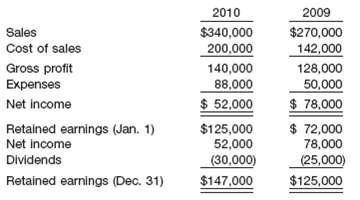Change in Estimate and Error; Financial Statements Presented below are the comparative income statements for Pannebecker Inc.
Question:
Change in Estimate and Error; Financial Statements Presented below are the comparative income statements for Pannebecker Inc. for the years 2009 and 2010. The following additional information is provided:
1. In 2010, Pannebecker Inc. decided to switch its depreciation method from sum-of-the-years?-digits to the straight-line method. The assets were purchased at the beginning of 2009 for $90,000 with an estimated useful life of 4 years and no salvage value. (The 2010 income statement contains depreciation expense of $27,000 on the assets purchased at the beginning of 2009.)
2. In 2010, the company discovered that the ending inventory for 2009 was overstated by $20,000; ending inventory for 2010 is correctly stated.?
Prepare the revised retained earnings statement for 2009 and 2010, assuming comparative statements. (Ignore income taxes.)

Depreciation is an important concept in accounting. By definition, depreciation is the wear and tear in the value of a noncurrent asset over its useful life. In simple words, depreciation is the cost of operating a noncurrent asset producing... Ending Inventory
The ending inventory is the amount of inventory that a business is required to present on its balance sheet. It can be calculated using the ending inventory formula Ending Inventory Formula =... Financial Statements
Financial statements are the standardized formats to present the financial information related to a business or an organization for its users. Financial statements contain the historical information as well as current period’s financial... Salvage Value
Salvage value is the estimated book value of an asset after depreciation is complete, based on what a company expects to receive in exchange for the asset at the end of its useful life. As such, an asset’s estimated salvage value is an important...
Step by Step Answer:

Intermediate Accounting
ISBN: 978-0470423684
13th Edition
Authors: Donald E. Kieso, Jerry J. Weygandt, And Terry D. Warfield





